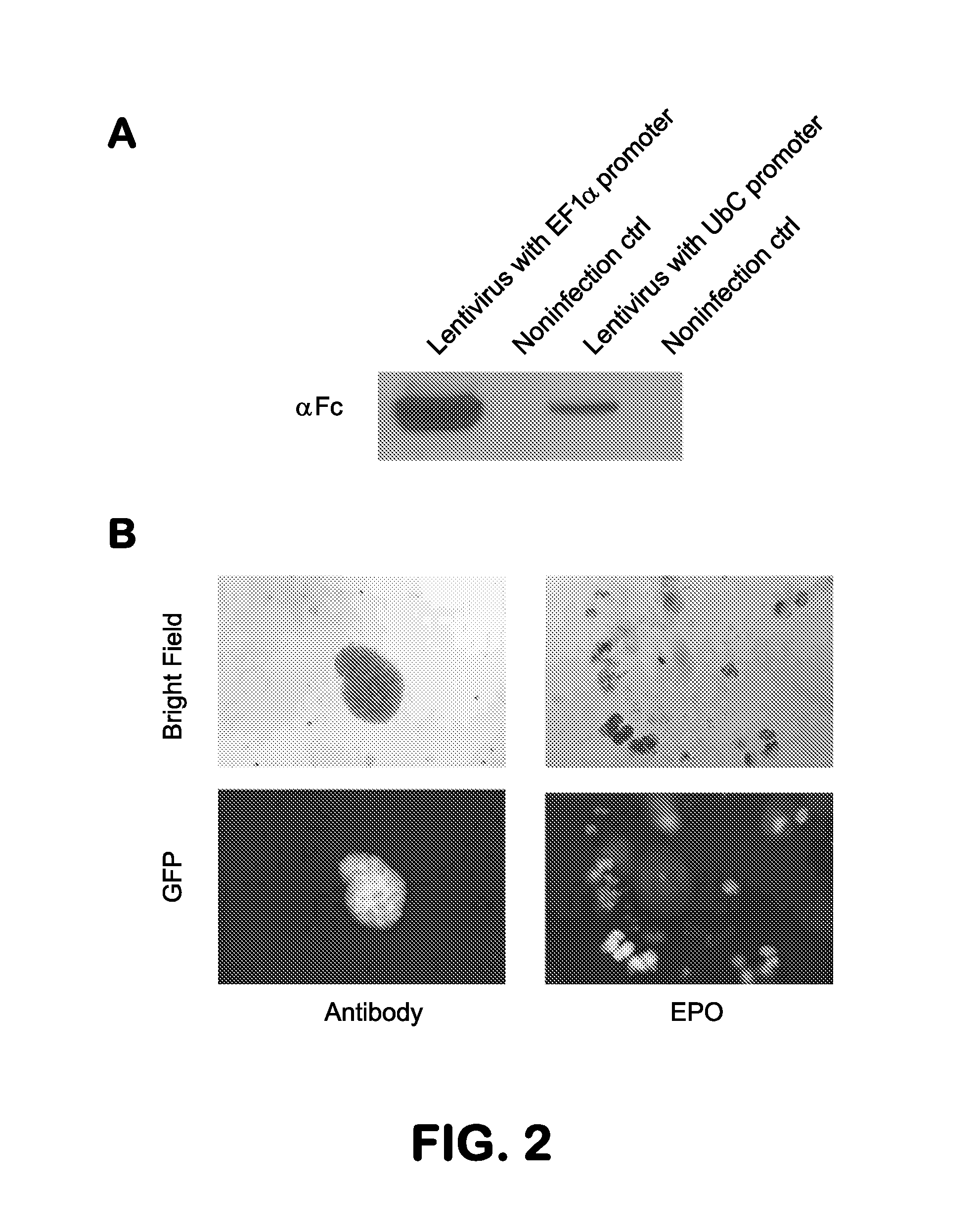Methods and compositions related to modulators of eukaryotic cells
a technology of eukaryotic cells and modulators, applied in the field of methods and compositions related to the modulator of eukaryotic cells, can solve the problem of painstaking process of isolation of antibodies whose function goes beyond simple binding
- Summary
- Abstract
- Description
- Claims
- Application Information
AI Technical Summary
Benefits of technology
Problems solved by technology
Method used
Image
Examples
example 1
Materials and Methods for Functional Selection of Agonist Antibodies
[0119]This Example describes some materials and methods employed in selecting Epo agonist antibodies.
[0120]Cell lines. The TF-1 cell line was maintained in RPMI 1640 (Gibco-Invitrogen) containing 10% fetal calf serum (FCS) (Gibco-Invitrogen), penicillin and streptomycin (Gibco-Invitrogen) and 2 ng / mL GM-CSF (R & D Systems). The HEK293T cell line was maintained in DMEM medium containing 10% FCS, penicillin and streptomycin (Gibco-Invitrogen). The HEK293F cell line was maintained in Freestyle 293 Expression Media with 4 mM Glutamax (Gibco-Invitrogen).
[0121]Construction of plasmids. The toolkit plasmids were constructed for making the lentiviral combinatorial antibody library and expression of the scFv-Fc fusion proteins. The relevant features of the plasmids are labeled in the vector maps shown in FIG. 7. All the vectors were designed so that the antibody genes could be exchanged between them with a simple SfiI digest...
example 2
Isolation of EpoR Binding Antibodies from a Combinatorial Library
[0138]The initial goal of the method was to express as large an antibody library as possible inside eukaryotic cells where the antibodies can either be contained in the cytoplasm or secreted. To accomplish this in a way that gives the greatest degree of freedom, we used both M-13 phage and lentivirus vectors that were constructed so that the antibody genes could be easily interchanged (FIG. 7). In general there are two approaches to this problem that depend on whether the target is known. One could use either conventional panning of a combinatorial antibody library in phage to enrich for antibodies against the target proteins and then switch the selected genes into lentiviruses or we could use the lentivirus library directly without prior selection (FIG. 1). Initial selection in phage is optimal when the target is known because phage systems can interrogate a much larger diversity space (approx. 1.0×1011) than is possi...
example 3
Selection of Agonist Antibodies
[0139]The genes encoding the antibodies that bound to the EpoR that were selected in phage by each protocol were transferred separately to lentiviruses which were used to infect TF-1 cells that we had engineered to overexpress the wild type EpoR. Expression of wild type EpoR (wt EpoR) in TF-1 cells is a necessary complement to their endogenous truncated EpoR for sustained cell growth. To facilitate study of the expression of the EpoR, the wt EPOR and GFP were linked with a T2A linker (FIG. 7). The expression of antibodies in the cells infected with lentiviruses, using either the EF1α or the UbC promoter, was analyzed by western blot analysis (FIG. 2A). The amount of antibody expressed was higher with the EF1 α promoter. (FIG. 2A).
[0140]The human TF-1 cells that we engineered to express wt EpoR required EPO for growth. To determine if any expressed antibodies could substitute for EPO, infected and control cells were plated in EPO-free soft agar and obse...
PUM
| Property | Measurement | Unit |
|---|---|---|
| pH | aaaaa | aaaaa |
| volume | aaaaa | aaaaa |
| concentrations | aaaaa | aaaaa |
Abstract
Description
Claims
Application Information
 Login to View More
Login to View More - R&D Engineer
- R&D Manager
- IP Professional
- Industry Leading Data Capabilities
- Powerful AI technology
- Patent DNA Extraction
Browse by: Latest US Patents, China's latest patents, Technical Efficacy Thesaurus, Application Domain, Technology Topic, Popular Technical Reports.
© 2024 PatSnap. All rights reserved.Legal|Privacy policy|Modern Slavery Act Transparency Statement|Sitemap|About US| Contact US: help@patsnap.com










